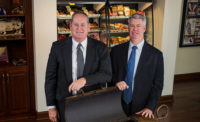The public side of the relationship has featured suspicion, overemphasis on bad-apple examples and often biased, misleading claims made by activists against the industry. It has been a dysfunctional existence built around mistrust and the ability of the loudest voices to get the most publicity.
On the industry’s side of the equation, its own response, for a very long time, had been to shutter itself behind closed doors and react only when attacked.
“[Many people thought], ‘If our procedures are working and we believe we’re doing the right thing, then let’s defend that,’” explains Dennis Treacy, senior vice president, corporate affairs, and chief sustainability officer for Smithfield Foods. “Well, that doesn’t work anymore.”
Indeed, some protein processors are coming out of their shells and exploring new ways to inform the masses about their business. Just as companies want to be nimble in their operations from farm to fork, these processors have a level of flexibility in dealing with new media, from video to social media such as Twitter, Facebook, etc.
Smithfield Foods — which had been attacked repeatedly through a variety of books, stories, movies and videos — realized this nearly a decade ago, transitioning itself to become a more transparent, more informative member of the new media conversation.
“Ag for years has been of the opinion that we need to educate city folks, and I’ve slowly but surely determined over the last 10 years that that is almost tilting at windmills,” Treacy says. “We’re not going to be able to get children that live in New York City to come to the farm; we’re not going to get kids in Seattle to understand that it’s OK to raise animals to eat.”
“But what we do have with social media, YouTube and the Web is the ability to show the world what we do, not with the intent that they need a lecture and need to be educated, but with the intent of opening the doors,” he adds. Instead of joining conversations, Smithfield now starts many of them, using these new media vehicles to offer information to those who want it.
“It gives us the opportunity to have two-way, real-time communication, which is different,” explains Don Butler, director of government relations and public affairs for Murphy-Brown, Smithfield Foods’ independent hog-production company. “That’s a game-changer.”
Smithfield answers questions, concerns and complaints about practices and products, quickly and with honesty.
“The majority of the calls are that they had heard something, and they’re mad about it,” he says. “They call up to chew me out about it, but almost always, I’m able to engage them, ask if we can have a two-way conversation, and those calls almost always end well.”
Seeing is believing
An approach focusing on individual attention to emails and phone calls has always worked well, Treacy says, but to really make an impact, Smithfield needed something more.
“There are more than 300 million people in the United States, so when we get a call from a person who is not happy and we call them back, … we know they’re going to feel better about it and maybe tell 10 people about something that they learned,” he explains. “But we need a better way; we need a way to reach a lot more people. The people who make books, movies and videos are reaching for the masses, and they tell one side of a story.”
The answer was to create a more dynamic, wider-ranging media offering that could be accessed by anyone, who could then formulate their own opinions based on information from both sides of the coin.
“We could provide objective evidence to customers or shareholders [on our processes and results] — people who really wanted to see factual information. But we didn’t really have a way to communicate that to people who were merely curious,” Butler says. “When you’re one-on-one with someone on the phone, it’s really not hard to convince them [of how] it is. But you can’t take the whole world through a farm.”
So, a couple years ago, Butler approached Treacy with the idea to create a video series called, “Taking the Mystery out of Pork Production,” which would show the entire hog-production process at Murphy-Brown and be posted online. The project was quickly approved and fully supported by Smithfield and Murphy-Brown executives.
In just more than a year, the entire video series was scripted (though none of the answers were scripted, Butler points out), shot, edited and produced, and it made its debut on YouTube, SchoolTube and the Murphy-Brown Web site in March 2011. Butler says he wanted the video to have a realistic feel to it, rather than have it look as though actors were delivering scripted answers to easy questions.
“We interviewed and filmed real contract growers and people who make real feed and drive real trucks — people I work with every day,” Butler explains. “We found out Temple Grandin was going to be in North Carolina at another event, so I called her up and asked if we could come and talk to her on video for this series — I didn’t write a script for her either.”
At presstime, the seven-part series had racked up more than 2,800 views (totaling the views of all parts) on SchoolTube, and nearly 26,000 views on YouTube in just under six months.
Change as a catalyst
Smithfield has an open, meaningful dialog with its customers — retailers and foodservice operators — and that will continue down the road.
“They’re interested in educated answers and knowing the facts [about Smithfield’s sustainability programs],” Treacy says. “They’re also interested in people’s impressions of the industry, protecting their brand and making sure they’re not supporting a company that does bad things.”
One current initiative brought about by an open dialog with customers was Smithfield’s decision to convert its farms to facilitate group sow housing.
“It wasn’t consumer pressure or activist pressure — there was no pressure at all,” Treacy adds. “It came from interaction with our customers, who said, ‘Can’t you do this in a different way. It seems to us, all things being equal, if you could, it would benefit all of us,’ and we decided to move forward with it.”
Butler reports that by the end of the calendar year, the company will have converted approximately 30 percent of its total sow herd to group sow housing of one kind or another.
Treacy makes it clear that Smithfield is not using any open-door policy to invite outsiders to alter the company’s strategies, or to bow to pressure from outside forces — Smithfield recognizes that it must be flexible in order to keep up with technology, regardless of its ability to spread its message to the public.
“We’re going to continually change, and the public now, in this WikiLeaks world without secrets, is going to watch us change,” he says. “Sometimes they’ll demand change, sometimes we’ll change and get a reaction from them.”
“Either way, we need to continually get better, and to Smithfield, that means improving our efficiencies, improving our bottom line — and we’ll make no apologies for that because it’s what we do for a living — making animal health better, making environmental impacts much less,” he says.
All the while, Smithfield will use the new media tools to show people what it is doing and how it is trying to do those things better — for everyone that the process touches. In today’s cynical world, it will take small steps first — but Smithfield believes that once the factual information from the company spreads further out to the masses, momentum will keep it rolling along through new methods.
“People don’t believe us, they don’t believe the government, they don’t believe corporations, they don’t believe the media — they believe each other,” Treacy says. “We need to become one of the ‘each other’ by talking directly to people who have a concern or compliment. We have to react to them personally, because that’s what the world has become.”
As such, Treacy believes Smithfield — and the industry in general — would be remiss to draw the proverbial line in the sand and hunker down to play defense.
“New media is not a threat to us, it’s an enormous opportunity for us to tell our story, and for people to criticize what we do and have us interact with them for the first time,” Treacy concludes.
| Leading the discussion |
|
Andy Hanacek, editor-in-chief of The National Provisioner, sat down with Kathleen Kirkham, sustainability coordinator for Smithfield Foods, to discuss some of the trends she sees Smithfield following in terms of being proactive and informing people through a variety of media. What follows is a Q&A with Kirkham: Hanacek: How would you describe your daily work duties, in your own words? Kirkham: On a general basis, what I do is take all the wonderful things Smithfield Foods does, and find a way to communicate them to the public. For example, sometimes I will represent the company at our Learners to Leaders or Helping Hungry Homes events. But [it also] translates into communicating our messages to the public via social media. [The rest of my job is] different every day, but the one ongoing responsibility is social media. Hanacek: So, in a sense, you do a lot of public-relations type work, but with an extremely heavy slant toward social media? Kirkham: I hesitate to call it public relations, because that has the connotation of spinning things to benefit the company, and that’s one of the things I’ve been impressed with about Smithfield is that we don’t spin things — we just tell it like it is. When I came on board, Dennis [Treacy, senior v.p., corporate affairs, and chief sustainability officer] told me, ‘If someone asks you a question, be honest and give them the truthful answer.’ That public-relations connotation isn’t true here at Smithfield. Hanacek: Discuss your approach to being proactive in getting the word out about Smithfield’s good news, as sustainability coordinator. Kirkham: In my experience, social media is about 90 percent listening, and only 10 percent talking. A lot of what I do is just watching what other companies are doing, what’s going on in the social scene. I do think we are pretty progressive. I haven’t seen too many other food companies utilizing this stuff in a very positive way. It’s free, you post things and people will listen to it. But, even though I think we are pretty progressive, we still have a long way to go. We just started this program a year ago, and it takes a while to build a repertoire, so we’re still in the beginning stages of it. Hanacek: Which media tool do you believe has the most potential for Smithfield moving forward as a communicator? Kirkham: That’s easy — it’s video. I was researching the other day for a presentation I was giving, and I found out that YouTube is the world’s second-most popular search engine — Google’s No. 1 and YouTube is No. 2. I just found that to be shocking because it’s not Yahoo, a news site, or Wikipedia. It’s a site that’s all video and all user-generated. There’s no fact-checking or anything like that either — you’re finding things that some user just put up there. And that’s terrifying for a company like us, … that that is where people are getting their information, because much of it is inaccurate or outdated — so that’s where we need to go, to show folks how we really operate and the truth about modern food production. Hanacek: How does Smithfield handle responding to complaints or incendiary comments? Maybe someone says they just watched an activist-produced movie and is angry at Smithfield for how it was depicted, for example — do you have a standard operating procedure or does your response vary? Kirkham: We definitely don’t have a standard procedure, because like I said before, we’re trying to just answer people’s questions, so it will depend on what the question is. … We always answer someone the first time — if it’s the first time we’ve heard from someone, we’ll talk to them. And usually if someone were to refer to a particular movie, I’d ask them for their email address and tell them I’d love to send them more information about that. We try to take the conversation offline, especially on Twitter, since it allows only 140 characters, and it’s hard for us to state our case in that limited space. Traditionally, I’ll take it offline. On Facebook, I might take it to a Facebook discussion, as opposed to talking about it on the Wall. The surprising thing about it is, I would guess 70 or 80 percent of the responses we get after our reply is positive, thanking us for the information. So they’re really receptive to what we have to say, which was surprising to me, because I kind of expected them to just say, ‘Oh, go to Hell.” So that’s pretty cool. Hanacek: Where do you see Smithfield needing to build to keep moving forward? Kirkham: I can tell you that we are moving our [Corporate Social Responsibility (CSR)] report online. We’re building this new Web site scheduled to launch in November, and it will house our CSR report and be an interactive site that will be updated all the time. … Realistically, I’d love to see even more frequent reporting. I think regularly updated information will be valuable, and we’re consistently moving in the direction of increased transparency. |











